

Explore the history, culture, people and beautiful landscapes of Vietnam on the 63Stravel travel app
Download the 63stravel app

Historical relics in Dong Thap promise to bring you an exciting and profound journey of discovery. When arriving in this land, don't miss the opportunity to stop at special places to absorb the unique cultural and historical beauty of the Mekong River Delta. Join 63Stravel to learn about famous historical sites in Dong Thap in this article!
Top 14 historical sites in Dong Thap you should definitely explore
Below are some historical sites in Dong Thap you can visit for your trip to the West.
Trieu Am Pagoda (Thanh Dao)
Trieu Am Tu (Ong Chin Pagoda) is Buu Son Ky Huong pagoda, founded by Mr. Dao Ngoan in 1854. The pagoda is not only a place to practice religion but also a center for healing, spreading the teachings of the Four Graces and is a gathering point for patriots.
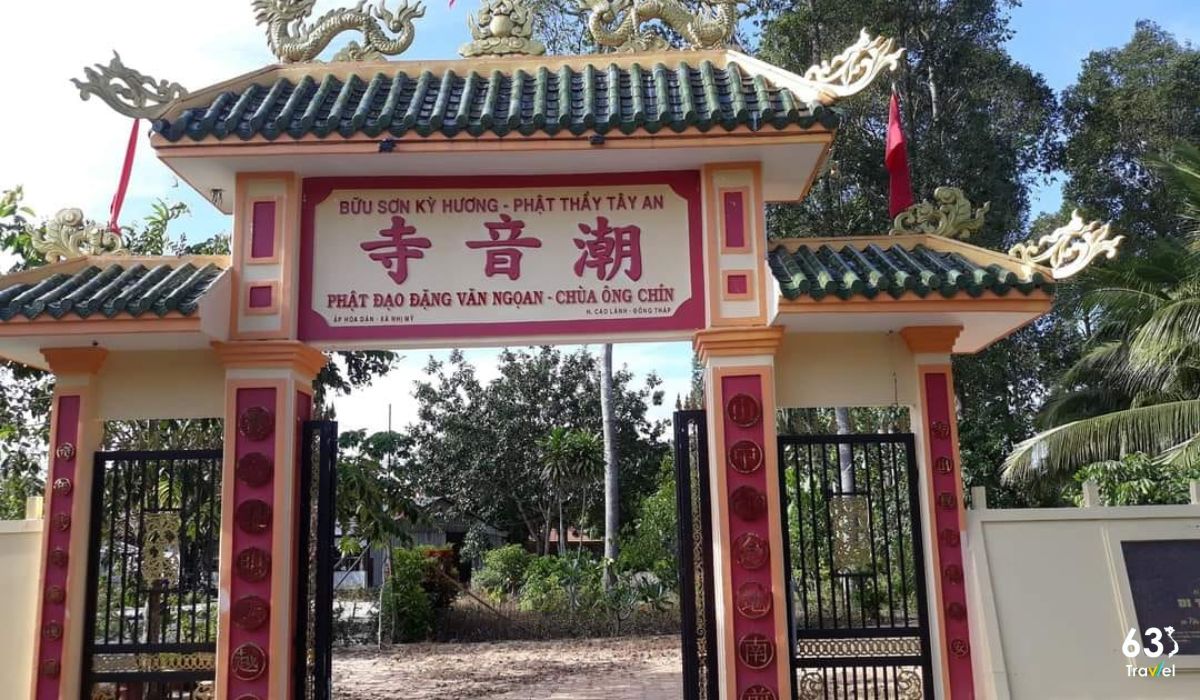
Explore Ong Dao Ngoan Temple of Master Buddha's Disciples
During the resistance period, the pagoda became an important revolutionary base, a refuge for cadres, and contributed to the resistance war against the French. Trieu Am Tu has been ranked as a provincial cultural and historical relic, preserving cultural values, patriotic traditions and virtues of compassion.
Dinh Yen Communal House
The communal house is a bold symbol of traditional Southern architecture, carrying unique artistic value with exquisite wood carvings - one of the pinnacles of Vietnamese craftsmen's skills in the early 20th century. . Ancient carvings, dragon heads and fish tails, blue panels, citadels, altars and cabinets made of mother-of-pearl all contribute to creating a majestic and respectful beauty, attracting a large number of tourists from near and far to admire it. and worship.
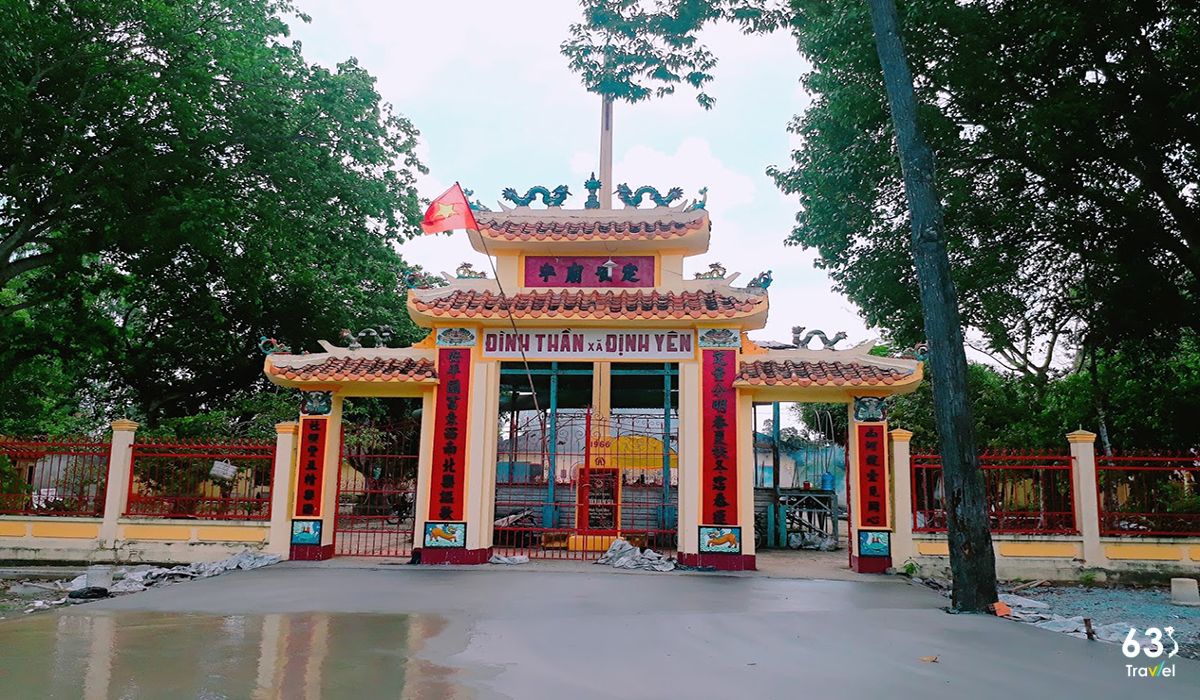
Dinh Yen Communal House - A cultural and historical mark in Dong Thap
It's not surprising that director Ly Hai chose this Dinh Yen communal house as the setting for the movie "Face 6 - Ticket of Destiny". During filming, scenes were meticulously staged to realistically and vividly recreate the life of a once "famous" craft village. After completion, the film crew restored the original state of the communal house, ensuring there was no intervention to change or deform the monument.
Currently, Dong Thap province is implementing a plan to preserve and promote the value of these two cultural heritages. Combined with tourism to introduce unique features of local culture to domestic and foreign tourists.
Buu Hung Pagoda
Buu Hung Pagoda is an ancient pagoda with typical Buddhist architecture of the Southern region. Built by Zen master Nguyen Dang in the mid-18th century with simple materials, the pagoda has undergone many renovations and expansions, carrying deep artistic and historical value. The pagoda was awarded the title "Sac Tu Buu Hung Tu" by King Gia Long in 1803, after Nguyen Phuc Anh took refuge here during the war against the Tay Son.
The pagoda has an area of about 4,000 square meters, with a triangular design including Front Hall, Main Hall and Hau To House. The main hall of the pagoda stands out with three spacious rooms and two wings, and the Spirit of Vong is exquisitely carved with four sacred animals. In addition, the ancient tower next to the pagoda is the resting place of the monks who practiced here.
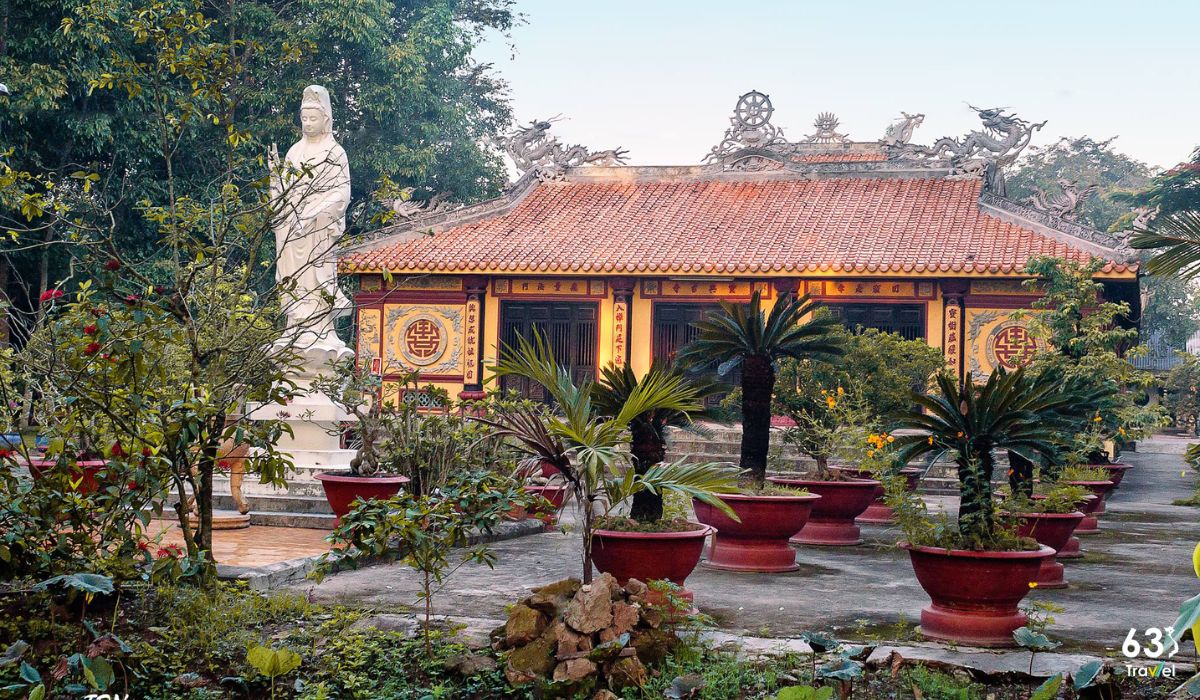
Buu Hung Pagoda - National historical and cultural relic in Dong Thap
A special feature of the pagoda is that most of the Buddha statues are made of many types of precious wood, including the wooden Amitabha Buddha statue donated by the Nguyen court in 1821. The pagoda also preserves more than 100 large wooden pillars. , three large sets of exquisitely carved wooden doors from the early 20th century.
Located in the middle of a quiet garden with a lotus pond and a romantic canal flowing through, Buu Hung Pagoda is not only a peaceful place of meditation but also an ideal pilgrimage destination for Buddhists and tourists. On major holidays such as Buddha's Birthday and Vu Lan, the pagoda organizes many special activities, bringing a sacred and peaceful space to those who visit.
Holy land of An Cung pagoda
The Holy Land of Kien An Cung Pagoda, also known as Ong Quach Pagoda, is a historical building nearly a hundred years old. Built in 1924 and completed in 1927 by the Fujian Chinese community, the pagoda is a typical symbol of Chinese culture and has been recognized as a national historical site since 1990.
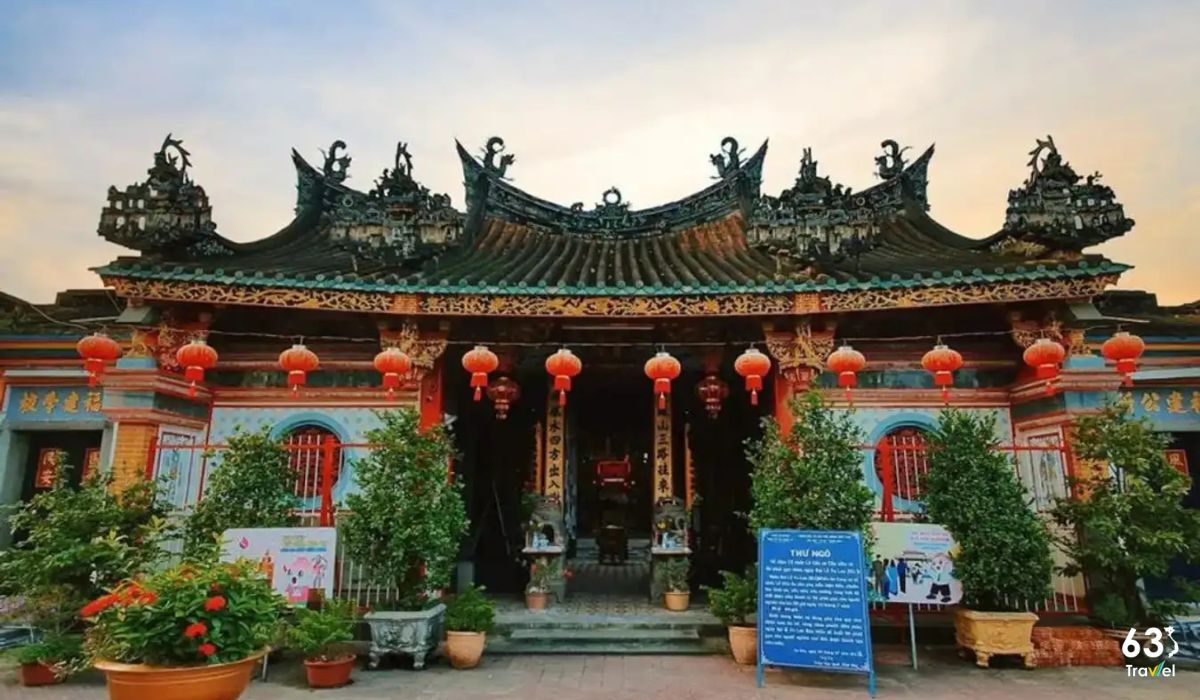
Kien An Cung - Ancient, sacred temple in the heart of Sa Dec
The pagoda is not only a place to worship ancestors and educate descendants, but also a center for community engagement, a place to meet and exchange information. The unique architecture of the pagoda is shown through the exquisitely crafted cement fence, which looks like rustic green bamboo poles, creating a beauty that is both splendid and solemn. The pagoda was built in the shape of the majestic letter "Cong", with a facade consisting of three main rooms and a yin-yang tile roof that curves softly like waves, symbolizing the spirit of overcoming difficulties and success.
When entering the Holy Land of Kien An Cung Pagoda, visitors will not be able to help but admire the exquisite wooden sculptures, the blue panels connecting the pillars, all crafted by talented artisans of Vietnam. Ancient China. Even though it has been nearly a century old, the pagoda still retains its grandeur, with unfaded drawings and architectural details, demonstrating the peak talent of the artisans at that time.
Dinh Yen mat market
Dinh Yen mat village is a traditional craft village with a long history and unique artistic quintessence of mat making. Here, the talented hands of artisans create products imbued with cultural imprints, reflecting the beauty of nature and the lives of local people.
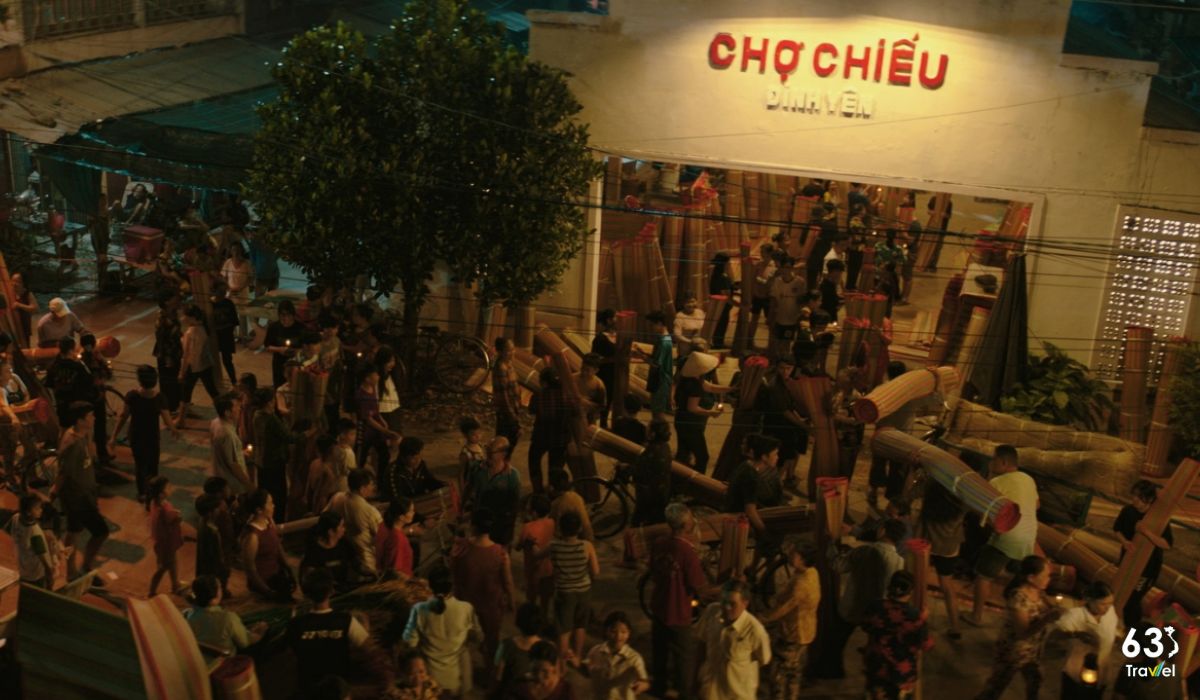
Dinh Yen mat village, Dong Thap - National intangible cultural heritage
Visitors to Dinh Yen mat village will have the opportunity to explore the meticulous mat production process from collecting raw materials, weaving, to completing the product. The mat village not only preserves a valuable cultural heritage of the Dong Thap region, but is also an attractive destination for those who want to experience and explore the exquisite beauty of the traditional art of making mats.
Tan Phu Trung communal house
Tan Phu Trung Communal House is one of the ancient and typical communal houses of Dong Thap, well worth visiting and exploring. The communal house worships the god Thanh Hoang Bon Canh, ordained by King Tu Duc in 1854. Having undergone many major restorations, notably in 1952 and 1957, Tan Phu Trung Communal House still retains its architectural features. characteristic of Southern communal houses during the Nguyen Dynasty in the early 20th century.
From the communal house gate, visitors will immediately feel the solemnity of the building with a solid main gate, sturdy brick gate pillars, and a ceramic unicorn statue on top. The communal house's spacious courtyard, paved with Chinese tiles, stands out with an 8m high flagpole standing in the middle, below is the Xa Tac Organ, an important spiritual symbol. In the yard, there is also the Son Than Temple and the Five Elements Temple, all of which create a symbolic space, reflecting the spiritual and cultural thinking of the agricultural residents here.
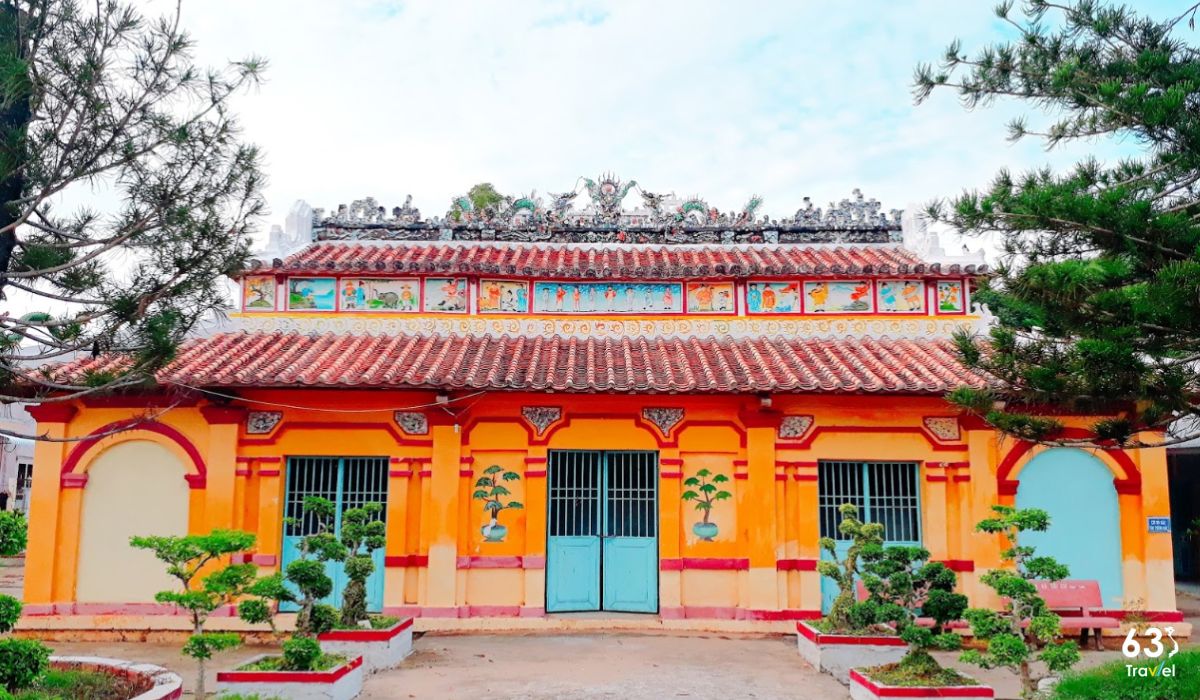
Tan Phu Trung Communal House - Ancient communal house located on the Nga Cai river
The main communal house is built with three arranged blocks of houses, each house has four main columns called four pillars, a solid structure with yin and yang tiled roofs and ornate motifs such as two dragons, pearl paintings, fish turning into dragons, The unicorn plays with the mother and child, the eight fairies and the phoenix hold a book. In the communal house, the carved panels of horizontal panels, bamboo panels, and couplets carry bold traditional art with the themes of Long - Lan - Quy - Phung and the four seasons of spring - summer - autumn - winter. In particular, the communal house also keeps three statues of Quan Thanh - Emperor - Quan made of rare agarwood, valuable artifacts of the communal house.
Not only is it an architectural work of historical value, Tan Phu Trung Communal House is also the center of community cultural and religious activities, contributing to preserving and promoting indigenous culture. With outstanding values, on August 15, 2012, Tan Phu Trung Communal House was recognized as a national historical-cultural relic.
Every year, Tan Phu Trung village communal house festival takes place on the 16th - 17th of the lunar calendar (even years) and the 12th - 13th of the lunar calendar (odd years), attracting tens of thousands of tourists to visit and worship. This is an opportunity for people to pray for peace, good weather, good harvests and a prosperous and prosperous life.
>> See more: Top 12+ tourist attractions in Dong Thap that will make you fall in love at first sight
Go Thap relic site
Go Thap relic area is a complex of rich historical and cultural relics, outstanding with pagoda towers, stone steles, Buddha statues and ancient catacombs. This place not only has profound architectural and spiritual value but is also an attractive destination for those who want to explore the unique cultural heritage of the Southwest region.
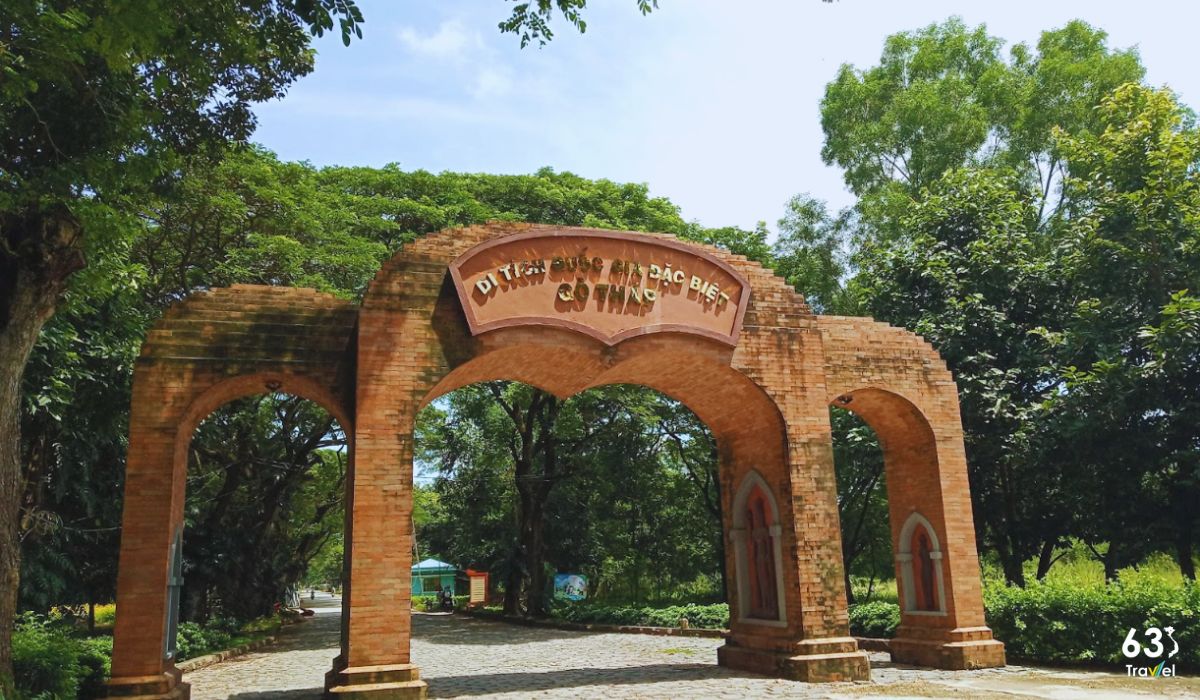
Go Thap relic site - Special national monument in Dong Thap
Recognized as a national relic since 1998, Go Thap preserves precious cultural and historical values, from the time of the Funan Kingdom, through the resistance wars against the French and the Americans, to the cultural layers. unique folk culture. With a system of interlaced canals and lush green cajuput forests, this relic not only bears a strong historical mark but also blends with wild natural beauty.
Ranked as one of Vietnam's 34 "special national monuments", Go Thap is a tourist destination not to be missed, with unique architecture and unique cultural and historical value. Visitors coming here will have the opportunity to explore the roots of ancient civilization and enjoy the sacred, peaceful space in the heart of nature.
Monument to the 1954 Gathering event
Even though 66 years have passed, the 1954 gathering to move troops to the North in Cao Lanh still retains its value, deepening the revolutionary tradition of the homeland. In order to remember this historical event and educate the spirit of patriotism for the young generation, Dong Thap province with support from provinces such as Ho Chi Minh City, An Giang, Tien Giang, Long An, Binh Phuoc, Binh Duong, Dong Nai and Tay Ninh, built a commemorative monument on an area of more than 12,000m² right at the event location.
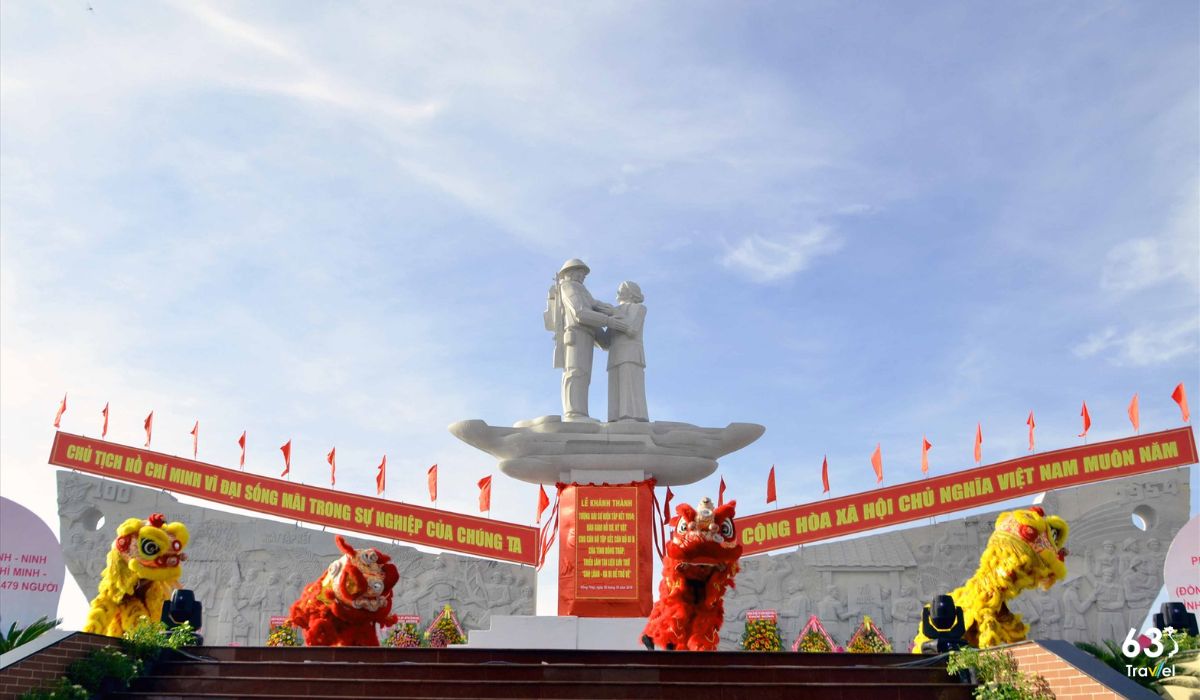
The gathering point for the North in 1954 in Dong Thap was recognized as a National Monument
The monument of the 1954 Gathering event has a design inspired by the image of a lotus flower blooming on the Tien River, with the main statue being the image of a Southern mother sending her children off to the gathering, symbolizing sacred affection and heart. sacrifices of the Southern people. Surrounding the monument are two bas-reliefs depicting activities and emotional farewell scenes during the gathering days in Cao Lanh. The image of an old mother wearing a bandana for her child, a young wife hugging her husband tightly, or a father giving a handful of homeland soil are beautiful symbols of love for the homeland and patriotism.
Located on the poetic Tien River, the 1954 Gathering Event Monument with modern architecture and harmonious green space is not only a work of historical and cultural significance but also a tourist destination. potential. This work not only marks historical events, but also contributes to educating patriotic traditions and serving political tasks in the period of international integration.
Phuoc Kien Tu (Lotus Leaf Pagoda)
La Sen Pagoda, also known as Phuoc Kien Tu, is one of the most famous pagodas in Dong Thap, attracting a large number of visitors from all over to visit and worship. The temple stands out with its ancient architecture and pure space, especially the giant lotus pond, a highlight not to be missed when coming here.
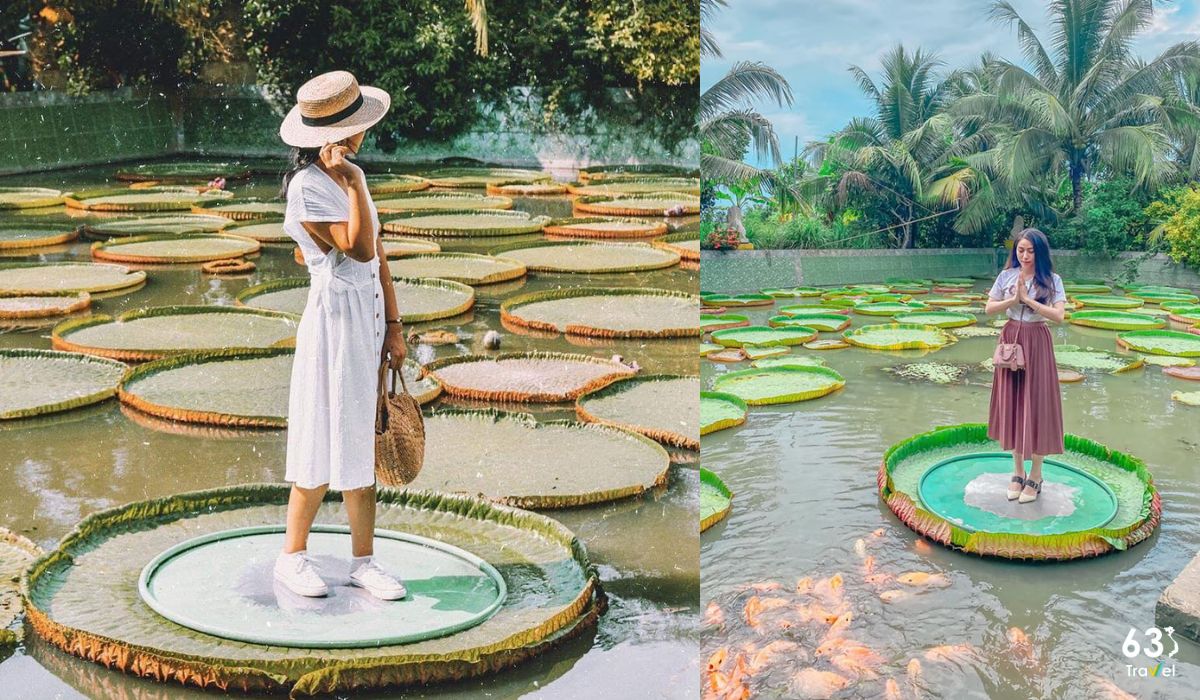
La Sen Pagoda - the hottest destination in the West during flood season
The temple's lotus pond area is the main attraction, with the square pond symbolizing earth and the round lotus leaf symbolizing heaven. This special type of lotus has appeared at the temple since 1992 and has been bred by monks, becoming more and more widespread and famous. Although local people have many different names for this lotus species such as king lotus, water lily or nong tam tree, it is officially known by the scientific name Victoria Regia, originating from the Amazon region.
Phuoc Kien Pagoda not only attracts tourists by its giant lotus pond but also by its history and unique architecture. Located in Hoa Tan commune, Chau Thanh district, Dong Thap province, the pagoda was destroyed during the 1966 war but was rebuilt in 1975, with a lotus pond created from bomb craters. The ideal time to visit is from September to January when lotus leaves bloom and create beautiful scenery. In addition to the lotus pond, the pagoda is also famous for its magical turtles and magical cranes, creating a unique and attractive spiritual destination.
Cao Lanh Temple of Literature
Cao Lanh Temple of Literature is an important destination in preserving and promoting the essence of Confucianism. Built in 1878, the Temple of Literature played an important role in worshiping Confucius and preserving precious books.
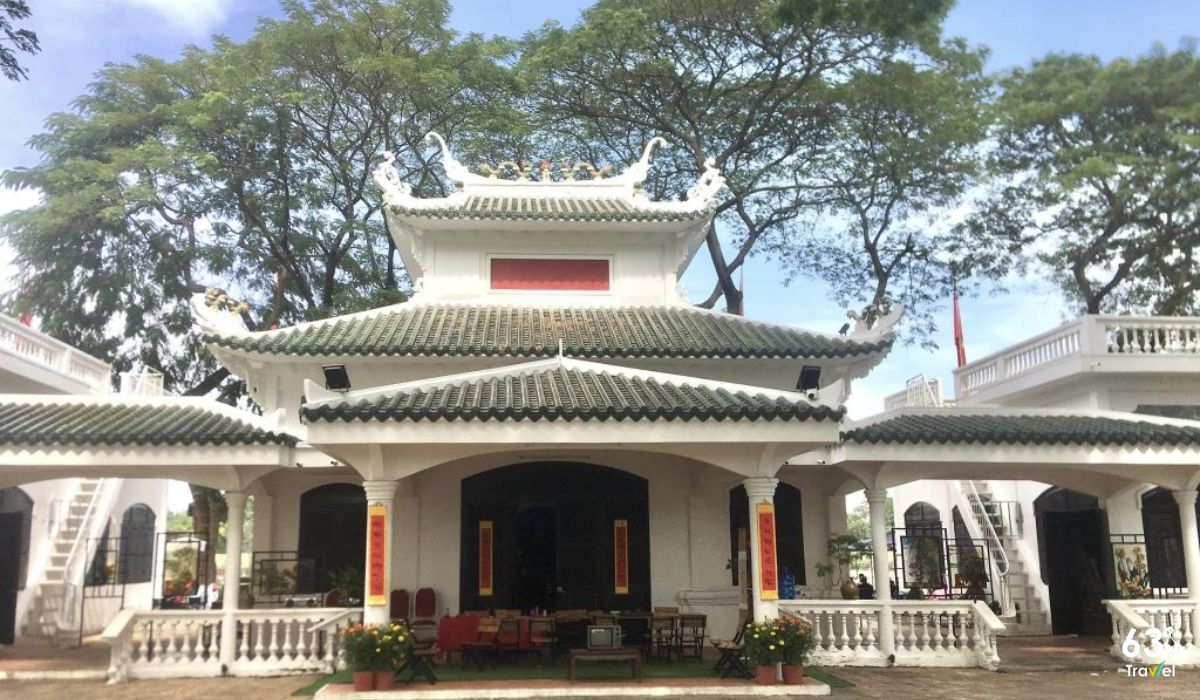 Văn Miếu Cao Lãnh - Biểu tượng của Nho giáo Việt Nam
Văn Miếu Cao Lãnh - Biểu tượng của Nho giáo Việt Nam
Today, the Temple of Literature has been expanded into a large park, creating favorable conditions for visitors to explore and experience. This work has been recognized as a provincial-level Historical-Cultural relic, marking its important role in the cultural and historical heritage of the region.
Huynh Thuy Le ancient house
Huynh Thuy Le ancient house is a unique cultural and historical heritage of Vietnam. Built in the late 19th and early 20th centuries, this house reflects a unique fusion of French architecture and Southeast Asian traditions. This is the work of Huynh Thuy Le family - a famous upper-class family in the area.
This place is not only an architectural symbol, but also associated with the borderless romance between French writer Marguerite Duras and Chinese-Vietnamese gentleman Huynh Thuy Le. This love affair became the inspiration for Duras's famous work "The Lover".
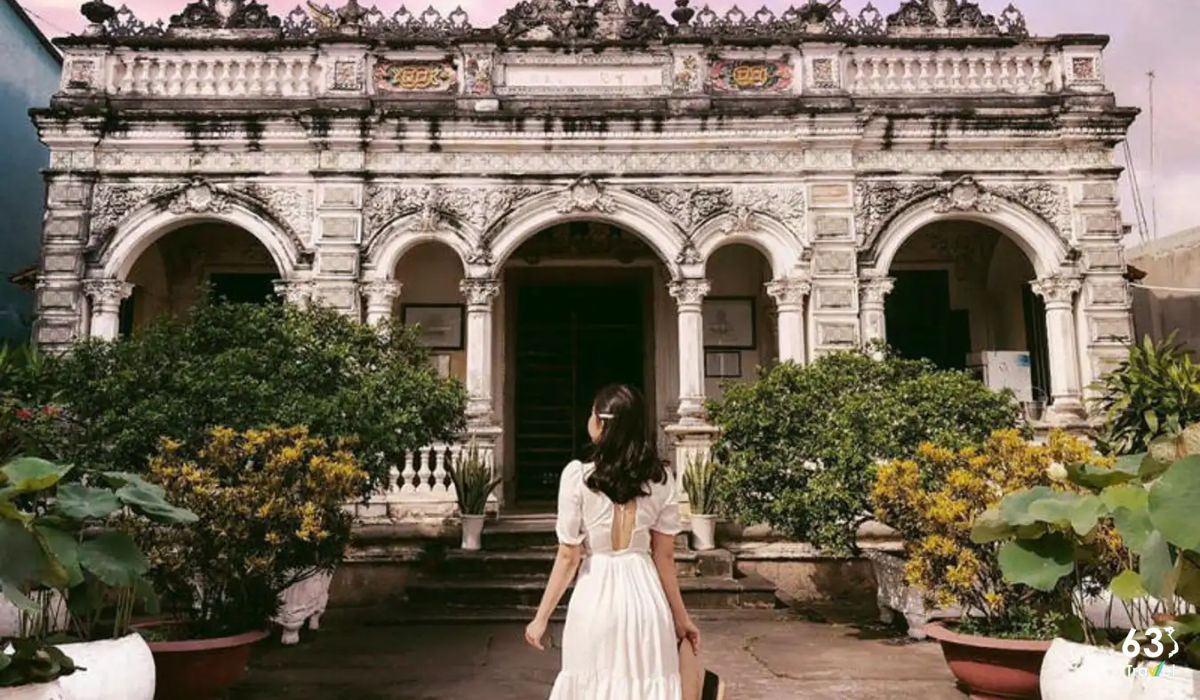
Huynh Thuy Le Ancient House - Preserves memories of love across borders
Initially, the house was built in the traditional three-compartment style of the Southwest, using precious wood and a yin-yang tiled roof. Currently, Huynh Thuy Le Ancient House has been recognized as a national monument, open to visitors to visit and explore the ancient architectural beauty, as well as learn about the life and history of the Huynh family. Thuy Le.
Located near the Sa Dec wholesale market, the house is not only attracted by its historical and cultural value but also by the wonderful blend of East and West architectural styles, creating an attractive destination for those who loves Vietnamese history, architecture and culture.
>> Should read: Let's visit 10+ historical sites in Dong Nai that attract tourists
Xeo Quyt Relic Area
Xeo Quyt - a tourist area combining historical and special ecological relics of the Southwest region. Known for its wild beauty and vividly recreated war zone relics, Xeo Quyt is located deep in the canals leading into the primeval forest. This area is also a protected area with rich biodiversity, including 170 species of plants and 200 species of wild animals, many of which are recorded in the Vietnam Red Book.
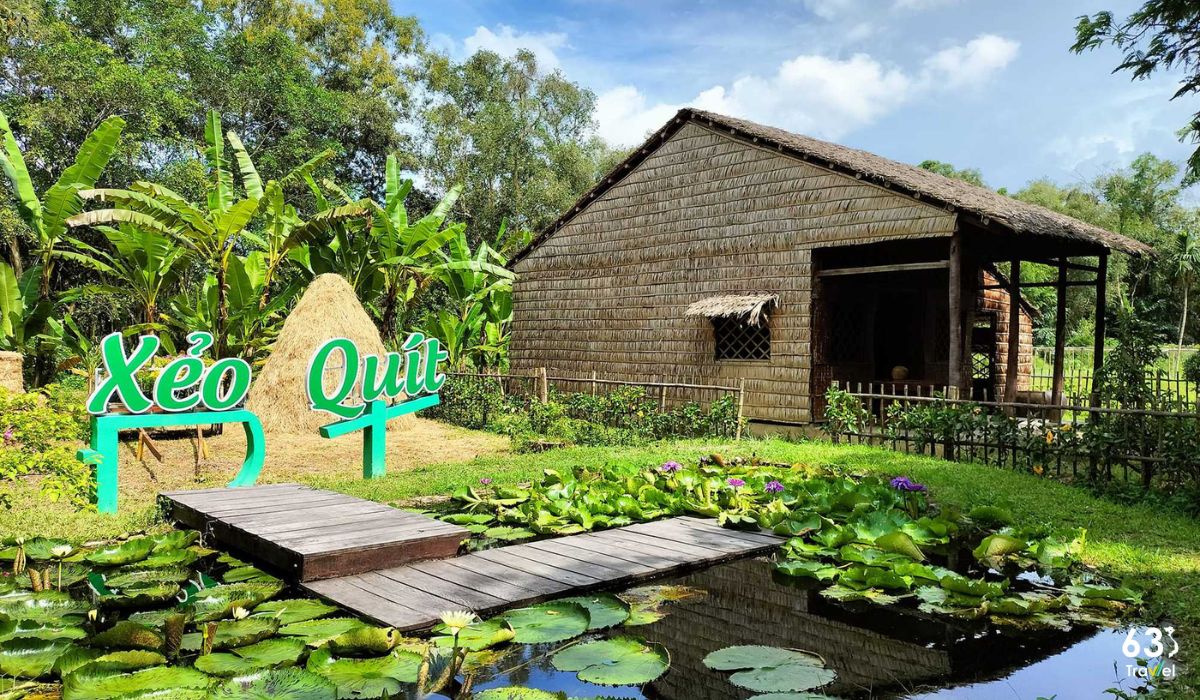
Xeo Quyt relic site - A unique eco-tourism destination combining history in Dong Thap
The ideal time to visit Xeo Quyt is from September to November, when visitors have the opportunity to experience rowing a dinghy through a 2 km long forest road. During this journey, the canoe driver will enthusiastically tell about the places where our troops once hid and fought during the war. Besides, the lotus pond and large lily pond are ideal places to take unique photos.
Xeo Quyt relic area has an area of 50 hectares, of which 20 hectares is melaleuca forest. This is home to many rare species of animals and plants such as cobras, pythons and box turtles. This area is also famous for bomb shelters and battle shelters, restored from historical traces. Recognized as a national historical site since 1992, Xeo Quyt is an ideal destination for those who love nature and history.
Phuong Nam cultural tourist area
Phuong Nam Cultural Tourist Area is an attractive new destination, with spacious space and a vivid picture of the history and culture of the South. Opened in 2017, the tourist area spreads over 17 hectares and includes five main items: Nam Phuong Linh Tu, Nam Phuong Linh Tu Dang family, Dang family museum, Nam Bo museum and Truong Lang Bao row. around, symbolizing the five continents.
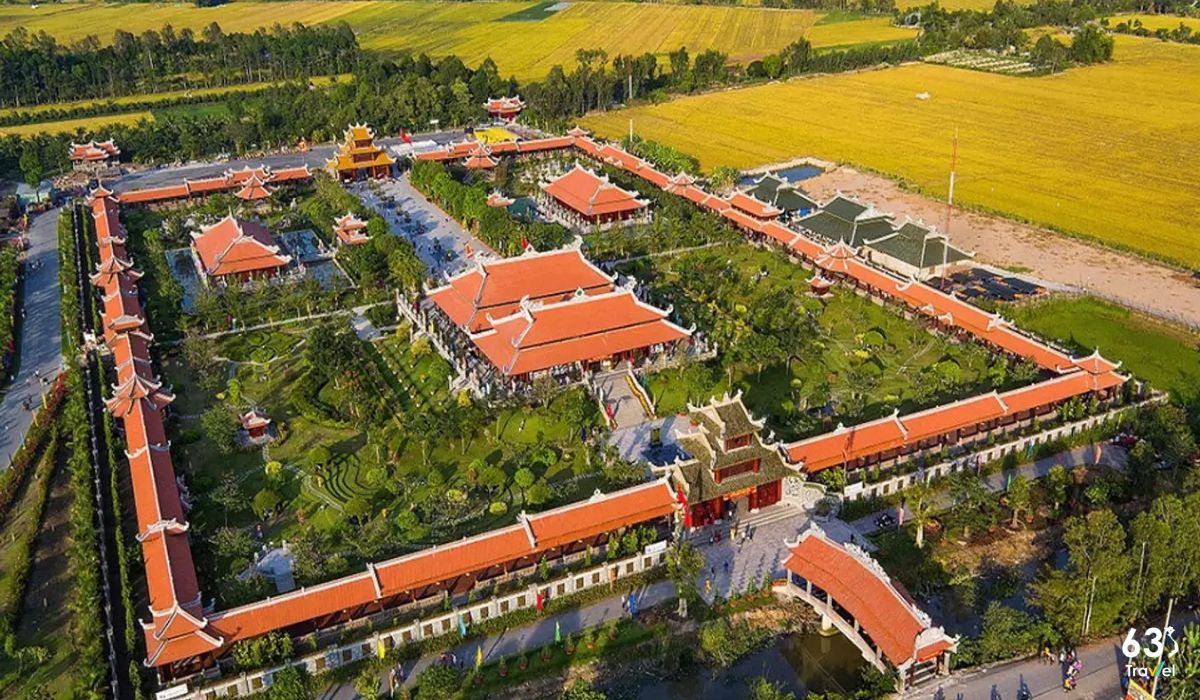
Phuong Nam Cultural Tourist Area - Nam Phuong Linh Tu in Dong Thap
This area stands out for its harmonious combination of nature and architecture. Lush green trees and blooming flowers create a pleasant, fresh atmosphere. The corridor covered with green trees and brilliant lotus ponds add more appeal. Nam Phuong Linh Tu Temple, with traditional Hue architecture, is a place to commemorate 125 historical figures of the South. Unique works of art such as tile bridges, Buddha statues and Southern village models, along with the Southern Land Museum, all contribute to creating a space rich in culture and history.
The relic site of Pho Bang Nguyen Sinh Sac
The Mausoleum of Deputy Bang Nguyen Sinh Sac is the resting place of Mr. Nguyen Sinh Sac, father of President Ho Chi Minh. This is an important historical relic, recognized as a national relic, carrying profound historical and spiritual value.
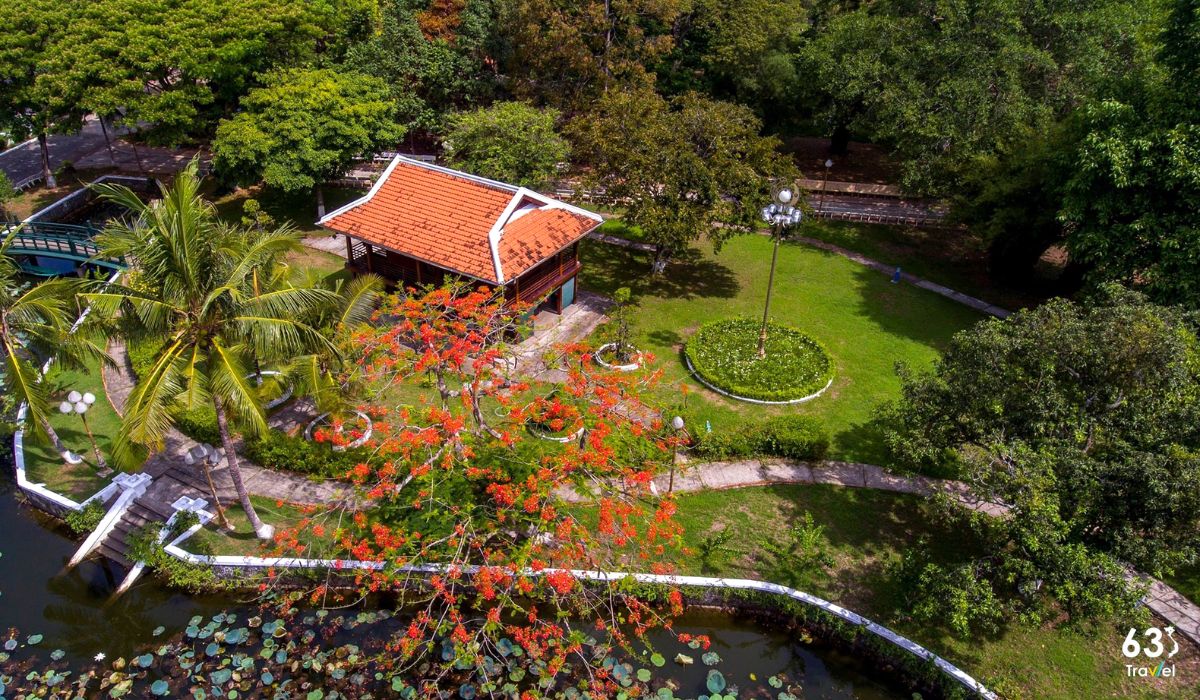
Nguyen Sinh Sac relic site - A place to preserve historical roots
This place is not only a place for people across the country to show their respect and memory of Mr. Pho Bang, but also a prominent destination of Dong Thap tourism. The relic grounds include a mausoleum and a stone tablet engraved with the image of Mr. Nguyen Sinh Sac and verses expressing his respect.
With unique architecture and solemn space, the relic not only reminds of the life and career of Mr. Nguyen Sinh Sac, but also deeply reflects the soul and spiritual values of President Ho Chi Minh. This is an ideal place for visitors to learn about history and culture, and feel connected to the cultural and spiritual values of the nation.
Above is a list of famous Dong Thap historical sites to make a trip to the West more interesting for all tourists. Let's save this list of relics to experience interesting things here!
Dong Thap 11147 view
Update day : 23/08/2024
Tram Chim National Park is a land located in the territory of 7 communes (Tan Cong Sinh, Phu Duc, Phu Tho, Phu Thanh A, Phu Thanh B, Phu Hiep), Tram Chim town in Tam Nong district. Tram Chim National Park has a total area of more than 7,500 hectares and is a typical miniature model of the Dong Thap Muoi region, with a diverse ecosystem, where visitors discover the characteristics of the Mekong River Delta. This land of "six months the fields are dry and the grass burns, six months the fields are flooded with white water" is where rich vegetation grows with more than 130 different species. The fauna here stands out with a rich water bird system including 233 species, belonging to 25 genera and 49 families. Of these, 88% were found in the dry season, accounting for 1/4 of the total number of bird species discovered in Vietnam. And especially the Red-crowned Crane, the largest in the Crane family - an invaluable natural asset of Tram Chim National Park in Dong Thap. The fish system in Tram Chim National Park is equally rich, playing both an ecological balance and a food source for birds. Among them, there are a number of fish species in the Vietnam Red Book such as: Com fish, Tiger Cobra fish, Male Seahorse fish, Flying fish, Euc fish, Ho fish... Tram Chim National Park is located about 160km from the center of Ho Chi Minh City and the road is quite easy to travel. From Saigon, you just need to go straight along Trung Luong - Tan An - Tan Thanh highway. When you reach the My An - Moc Hoa intersection, you turn to Truong Xuan and drive a little further to reach Tram Chim town. Then you will see many signs leading to Tram Chim National Park. Just follow the signs and you'll get there. Located about 35 km away from Cao Lanh city center, the road to Tram Chim National Park is quite easy. You can refer to the following suggested travel routes. Start at Cao Lanh city center (Cao Lanh City children's park, April 30 street) - follow National Highway 30 (NH30) to the intersection near Thanh Binh district medical center - continue to turn right. all the way to Tram Chim following the road signs. From Tam Nong district of Dong Thap province, you run straight across Tram Chim bridge and then continue about 800m to reach the conservation center of Tram Chim National Park. Remember to look on the left side. The reasonable time to travel to Tram Chim is the floating water season from August to November of the lunar calendar (around September - December of the solar calendar) which is the tourist season to Tram Chim National Park. The landscape is flooded, lush green, dotted with pink lotus flowers and blooming water lilies. The source of produce becomes abundant and birds seem to gather here to party. Around this time, it is also the bird breeding season. Here, visitors have the opportunity to witness firsthand the life and proliferation of birds, which is an interesting thing. Thousands of birds compete to feed each other (typically the red sandpiper and the gong), demonstrating sacred motherly love and bringing environmental education to the forefront for tourists from near and far, while also having the opportunity to preserve the image forever. Beautiful photos of good land where birds roost. This season is also an opportunity for you to participate in interesting activities such as: Rowing a dinghy to experience life in flooded areas, you will be able to personally carry out the livelihood work of flood zone residents such as setting nets, setting Roofing, sheltering, or trying your hand at Tram Chim Tam Nong fishing... especially, there is also the pleasure of hunting field mice, a specialty of this country. In particular, visitors can participate in harvesting sky rice, also known as ghost rice, a very special rice species because during the flooding season, other herbaceous plants will be submerged by the water, only sky rice will flourish. develop, wherever the water rises, the rice grows there. This will be a memory of the ancient life of Dong Thap Muoi residents. In addition, in the dry season from December to May of the lunar calendar (around January to June of the solar calendar) is the season to watch the dance of red-crowned cranes in Tram Chim National Park. Because unlike many species of birds in the area, red-crowned cranes only forage on the ground, so during the flood season in Dong Thap Muoi, they have to go looking for food elsewhere. Therefore, red-crowned cranes can only be seen in the dry season, most easily seen from February to May every year. You will have the opportunity to sit on a canoe (tac tong) weaving along the cool green canals, watching all kinds of birds flying around looking for prey, calling out to the noisy flock throughout the space. Flocks of hundreds of birds spreading their wings create a peaceful and charming scene. The boat follows the water, taking you to admire the beauty of fields of pink lotus, white lotus, heavenly rice, golden rice... stretching in the sunshine. A few robins, with bright red crests, dark green feathers, and fluttering tails, kept hiding and appearing in the grass as if they were playing hide and seek with tourists. The boat rowed through a small canal, weaving through the cajuput trees. Between the cajuput forests, a vast green grassland sways with the wind. The feeling of being in harmony with nature is wonderful. When you reach the lookout platform, the boat will stop completely so you can climb to the upper deck, enjoy the panoramic view of the immense green of Tram Chim National Park, relax with the caressing gentle breezes, and feel the closeness. with nature and feel strangely peaceful. Another very interesting thing at Tram Chim is watching the royal soul. The sun is like a silver-coated ball surrounded by colorful halos that slowly sink to the horizon. The entire river area suddenly turned pink and radiant. The afternoon sun splashes on the water's surface with variegated colors created by a magical, multi-colored mixture: bright yellow, orange-pink, bright white... truly a masterpiece of nature. After the journey to explore Tram Chim National Park, you will have the opportunity to sit on a cool thatched house in the middle of the forest or on floating rafts, enjoying delicious rustic dishes with country flavors such as: grilled snakehead fish, braised fish. water lily, snails steamed with pepper, crab hotpot, eel stewed with lemongrass, crispy fried fish cakes, dried snakehead fish, catfish, grilled barramundi. If you have the opportunity to come here during the lotus blooming season, you will also have the opportunity to enjoy many attractive dishes made from lotus.
Dong Thap 1847 view
September to December
Dong Thap has many historical relics, of which Xeo Quyt is one of the meaningful tourist destinations, leaving many beautiful impressions in the hearts of visitors. Xeo Quyt relic area with an area of about 50 hectares, including 20 hectares of primary cajuput forest, belongs to 2 communes My Hiep and My Long, Cao Lanh district, Dong Thap province. The historical relic combined with the Xeo Quyt ecological area will give visitors the feeling of being lost in a primeval forest with wild natural scenery. Visiting Xeo Quyt tourist area in the dry season, you will weave along zigzag trails more than 1.5km long under cool cajuput trees to get deep into the base. During high water season, on dinghies, guerrillas in ba ba shirts, bandannas, and duck-eared hats take tourists through small, pristine canals to reach relics hidden in the vast melaleuca forest. If you go during the lotus blooming season, you will be able to see a beautiful natural picture typical of Dong Thap Muoi. Xeo Quyt was the Revolutionary base (from 1960-1975) of the Dong Thap Provincial Party Committee that led the people in the resistance war against the US. During the resistance war, Xeo Quyt suffered many bombs and bullet storms from the enemy. But with national spirit, courage, endurance of danger and strategic intelligence, the army and people of Dong Thap turned the situation around, overcame difficulties, and brought victory to their homeland and country. Recognized as a national historical site in 1992, Xeo Quyt is a tourist destination that contains many interesting things of pristine nature and is a place that preserves traces of the arduous struggle period of Dong Thap's army and people. . After sightseeing and having fun, the Xeo Quyt food court and restaurant with a strong rural feel will be an ideal stop for you to enjoy the famous specialties of this country, such as: Grilled snakehead fish with lotus, and mice. Grilled fields, sour eels, grilled frogs, fish hotpot... What could be more interesting than eating rice while enjoying and exchanging amateur music, then freely exploring and visiting the primeval cajuput forest and fishing? entertainment, or hang a hammock to lie down under the smooth green canopy of Melaleuca forest... With the strength of natural conditions, Xeo Quyt still retains its wild features and idyllic rural setting. Xeo Quyt is truly a very special stop and is suitable for those who want to temporarily get away from modern life, full of busy pressures and tensions, to find a quiet, rustic place. At the same time as a cultural and historical destination, Xeo Quyt is also a place that connects past eras, increasing pride and love for the homeland and country.
Dong Thap 2006 view
From January to December
Gao Giong tourist area is an ideal place for you to take a sightseeing tour and enjoy garden life in the West. This is one of the few ecological areas that still retains almost all the wild characteristics of the Southern region and is known as "miniature Dong Thap Muoi". Gao Giong eco-tourism area is located in hamlet 6, Gao Giong commune, Cao Lanh district, Dong Thap province, only about 17 km from Cao Lanh city center. From Cao Lanh city, follow the route towards Tan Nghia commune, then continue to Gao Giong commune, you will see a sign leading to Gao Giong tourist area. Previously, Gao Giong was a deserted land, heavily contaminated with alum, with only a few species of flora and fauna living. But thanks to the investment and renovation process, Gao Giong has developed into a familiar resort destination for tourists from all over. The scenery here is still wild and quiet, very suitable for visitors to immerse themselves in nature and enjoy fresh air. The ideal time to travel to Gao Giong is from September to November when the West is in flood season. During the flood season, the water covers the fields, turning Gao Giong into an oasis amid the vast sky and water. The yellow of the Sesbania flower, the purple of the water lily mixed with the pink of the lotus petals, and the lush green of the Melaleuca forest emerge. In the fields, white storks diligently search for food, creating a breathtaking scene. The lotus fields - where thousands of red comb herrings gather here to dance and bustle all day long. On the herb feeding grounds, thousands of bold birds with red combs on their blue feathers leisurely pluck fresh stems. Sometimes they crow with beautiful dances. If you want to visit the bird garden, visitors can go on small boats down the green canal with village girls in Southern-style Ba Ba dresses or ride bicycles around the fields. But tourists often prefer to visit by waterway so that they can weave through the canals to admire the scenery, enjoy the feeling of floating on the water, weaving through each cajuput forest, listening to the welcoming sounds of birds singing. … Those who have been to Gao Giong tourist area have the overwhelming feeling of being lost in the land of birds. This is home to 15 bird species and hundreds of aquatic species. The birds pose gracefully, spread their wings and then land quickly, so visitors have to quickly take pictures to capture those beautiful moments. Not only that, Gao Giong is also covered by the vast green of thousands of hectares of forest with all the typical tree species of flooded areas such as: cajuput, gao, sesbania, reeds, wild rice, etc. You will feel excited when you see with your own eyes precious birds such as the copper-billed herring, teal, gong, mallard, heron... living and nesting. Most numerous is still a flock of tens of thousands of white storks, making this Melaleuca forest considered the largest stork garden today in the Dong Thap Muoi region. At dawn or dusk, Gao Giong Melaleuca forest is lively and bustling with the sounds of birds calling and flocks of white storks returning to their nests from all four directions. After hours of canoeing, you can climb up to the 18m high observation deck to see the surrounding panorama and admire the vast green of cajuput, rice, energy forests... Spread your arms wide, breathe the fresh air. peaceful, and you will feel like you are holding a beautiful natural picture in your heart, an indescribable feeling of peace. In Gao Giong, there are also many folk games that help Dong Thap tourists understand more about a part of Southern cultural life. If you come here in a group or group of friends, don't miss the opportunity to 'play hard, laugh freely' with the games. For those who like quiet, you can choose the elegant hobby of fishing to both get results and peacefully enjoy the wonderful atmosphere here. When visiting Gao Giong eco-tourism area, don't forget to go to the food court to enjoy all the Western specialties. Typical dishes include imitation worm leaves dipped in tamarind sauce, grilled mice, flexible fish cooked in sour sesban soup, grilled snakehead fish with lotus buds, cool vegetables, braised fish sauce dipped in coconut vegetables, steamed snails with pepper, pancakes... Especially The rice dish wrapped in lotus leaves is delicious and rich in the flavor of the lotus lagoon. Sitting in the middle of the lagoon having lunch is an extremely enjoyable experience. There is nothing better than delicious food, cool breeze, and the faint scent of lotus. The dishes will become a little more flavorful with a glass of sticky rice wine mixed with cajuput honey. If you have the opportunity to travel to Dong Thap, do not miss a visit to the Gao Giong eco-tourism area, this "green oasis" will give you typical experiences of the southern region of the river and downstream areas. will take you on a tour through the Melaleuca forest, relaxing with the sound of birds chirping or delicious garden dishes will be things you will never forget about this wonderful tourist area.
Dong Thap 2071 view
From January to December
When mentioning Dong Thap, people immediately remember the poem "Thap Muoi is the most beautiful lotus". Pink lotus flowers with yellow pistils, raised sepals and lush green leaves create a strangely peaceful scene. Among the lotus fields in Dong Thap, the most prominent is Thap Muoi Lotus Field in My Hoa commune, Thap Muoi district, Dong Thap province. Coming to Dong Sen Thap Muoi tourist area, watching lotus and enjoying Western river specialties is a wonderful and exciting experience for visitors. Thap Muoi lotus field, about 35 km from Cao Lanh city, about 150 km from Ho Chi Minh City. The road to this place is also very convenient, without many crowded vehicles often found in tourist areas. If you come here from Ho Chi Minh City, you can go towards An My town, cross My An bridge and turn left. With an area of nearly 20 hectares, no crowded traffic, no dust, no jostling or noise often found in tourist destinations, Thap Muoi lotus field is strangely peaceful and close! With a large area, when coming to Thap Muoi lotus field, visitors will have private space without having to jostle or compete to see the lotus. Cool green lotus fields mixed with pink lotus flowers gently swaying in the wind captivate visitors. Traveling to Dong Thap in any season is beautiful and the air is fresh. However, Dong Sen Thap Muoi is most beautiful in the summer, when the lotuses are in full bloom, one flower squeezing another flower to reach the sun. Dong Thap Muoi lotus begins to bloom in the morning. The lotus flower is white at first, then turns pink at noon. At around 3:00 p.m., the lotus turns dark pink, then turns red as the sun sets. The next day, the lotus continues to bloom and change color in this cycle for 3 days, then turns dark purple and fades. As this flower fades, another flower grows and blooms, this is something only the Thap Muoi lotus can do. Visitors can also walk around to admire the lotus, breathe in the scent of pink lotus... or can transform into village girls or garden boys when returning to the lotus field. The tourist area also has a page rental service. Dressing in ao dai, ao dai... saves beautiful moments beside the lotus petals with friends and relatives. This is also an ideal location for couples choosing to take wedding photos. Visitors can take a canoe to move deep inside, admiring the countryside and feeling the closeness and peace of nature. Inhale the fresh, cool air of the morning, gently touch each leaf, each flower, gently stroke the cool water with your hand. The boat drifts slowly and takes you inside. As you go, you can admire the scenery on both sides of the river and experience a day of being a "real" farmer by leaning on the boat to pick lotus and fish. To create a space to stop and rest for tourists, people built leaf huts and in these leaf huts, people can enjoy local specialties, in which of course the presence of tourists is indispensable. lotus. lotus. Grilled snakehead fish rolled in young lotus leaves, chicken salad with lotus roots, lotus sticky rice, lotus sweet soup... Especially, when coming to the lotus field during the flood season, visitors can also eat flexible fish, sesbania flowers, grilled field mice, roasted mice. ...All are prepared according to a very unique method of the people here, so they have a very unique flavor that cannot be found anywhere else. The special dish here is snakehead fish grilled with lotus leaves and served with young lotus leaves. Young lotus leaves are a clean vegetable, grown in clean, unpolluted water. The distinguishing characteristic is that the lotus leaf just rises above the water's surface, with the two edges of the leaf curled into the middle. Grilled snakehead fish with old lotus leaves because the fish is too thick and takes too long to burn, so people often roll many layers of lotus leaves when grilling. Grilled snakehead fish is served with raw vegetables, vermicelli and tamarind fish sauce. It's still a plate of raw vegetables, bananas, and sour star fruit, but the special thing is that this dish has young lotus leaves to roll with the fish. Young lotus leaves have a sweet taste and are rolled together with grilled snakehead fish, vermicelli, bananas, and star fruit dipped in tamarind fish sauce. The flavor bursts in the mouth, creating a unique and delicious taste that is typical of the Dong Thap Muoi region.
Dong Thap 1918 view
From January to December
For those who love nostalgia and want to relive the prosperous and wealthy period of the most luxurious family in Sa Dec at that time, the ancient house of Huynh Thuy Le is definitely an ideal place. Huynh Thuy Le ancient house is an ancient house with an architectural combination of the two most unique East and West architectural styles in the Southern region. This is the residence of Mr. Huynh Thuy Le, the male protagonist in the novel "The Lover". The house became famous around the world when the autobiography of female writer Marguerite Duras was turned into a movie of the same name (L'Amant) in 1991. Everything here seems to have been frozen in time, dyed even by time. An ancient, quiet color but still exudes elegance and sophistication. Huynh Thuy Le ancient house is located at 255A, Nguyen Hue Street, Ward 2, right in the center of Sa Dec city, Dong Thap province, on the banks of the romantic Tien River. This house is known to everyone as Huynh Thuy Le Ancient House, named after the late owner, Mr. Huynh Thuy Le, a wealthy Chinese-Vietnamese in the early 20th century. The ancient house was built in 1895 by Mr. Huynh Cam Thuan (father of Mr. Huynh Thuy Le), a Chinese businessman (Fujian, China) who was famous and wealthy at one time in Sa Dec, in the middle of the shopping district. bustling location located along the Sa Dec river. Initially, this was a traditional three-room house of the Southwest region, 258 m2 wide with the main materials being precious wood, and a boat-shaped roof covered with yin and yang tiles. In 1917, the owner restored the house with solid bricks covering the wooden frame inside. Therefore, on the outside it looks like a French-style villa, but inside, you see an architectural style with bold Chinese colors. The roof has the shape of a boat from the Western region, while the arches are curved in Roman style, carved with reliefs of flowers, plants, and birds of the 17th century. Western architecture is clearly shown in this part. The house's facade, ceiling, window frames... are all decorated with Renaissance-style reliefs. Curved arch according to Roman architecture. The Eastern architecture is seen through very sharp carved lines and gilded lacquer like images of birds, fruit trees and flowers such as bamboo, apricot, chrysanthemum, peach... The outside of the ancient house has ants. Western architecture mixed with Chinese style. Many types of house building materials such as bricks and glass are imported from France. The 30x40cm floor tiles were imported from France in 1917. The back of the tiles clearly states the place and year of manufacture. In particular, the tile floor in the middle of the house is sunken because Mr. Huynh Cam Thuan believes that "water flows to a low place." , money will flow to your house. The middle of the house is the altar to worship Quan Cong, a traditional belief that shows the strength and prosperity in the homeowner's life. The walls and walls are made of precious wood, painted with gold, and elaborately carved, showing the nobility of wealthy families in the past. The architecture in the house is also decorated according to the four sacred feng shui style, but it is Long - Lan - Bat - Phung, not Long - Lan - Quy - Phung as traditional. The image of the bat replacing the turtle in the four sacred animals is considered a symbolic example of the cultural exchange process of the Chinese people when they came to the Western river region. After many ups and downs of history, up to now, the house is still preserved quite intact and has become a symbol of a unique architecture hundreds of years ago. Guests who want to stay overnight can book a room in advance. Each room sleeps 2 people and serves breakfast and lunch. The ancient house has been known to many people since the novel L'Amant by French writer Margueritte Duras was made into the movie The Lover by director Jean-Jacques Annaud with the acting of actor Luong Gia Huy and actress Jane March. . The details in the movie have brought tears to many people's eyes when watching. Huynh Thuy Le is the main character in this famous novel and this French female writer is also Mr. Huynh Thuy Le's lover. The two met by chance on the My Thuan ferry in 1929, when she was just under 16 years old and he was 32 years old. They had a beautiful love relationship with each other. However, they faced strong opposition from Mr. Huynh Cam Thuan. When his father found out, Mr. Le knelt down and begged his father to let him live with the girl for whom he felt a strong love that could only come once in a lifetime. But because of the cultural differences between East and West and the lack of family registration between the two families, the father did not agree to let the two get together. The relationship only lasted 18 months. The day Marguerite boarded the train to return to France, from the side of the train she saw in the distance the familiar black luxury car of her Chinese lover quietly coming to say goodbye. Not long after that, he obeyed his father and married a young Chinese woman. Many years later, after many broken lives, he had the opportunity to go to Paris with his wife. He called her to propose just to hear her voice. “Then he told her that just like before, he still loved her, he could not stop loving her, he could never stop loving her, he loved her until death” (excerpt novel The Lover). After Mr. Huynh Thuy Le passed away, his children all settled abroad. The house of Mr. Huynh Thuy Le's family was requisitioned by the State as the headquarters of the Economic Police Team of Sa Dec Town Police. By 2007, Dong Thap tourism industry officially "opened" to exploit the ancient house, serving domestic and foreign visitors. In 2008, the ancient house was certified as a provincial relic, and was recognized as a national relic in 2009.
Dong Thap 1906 view
From January to December
Among the many famous pagodas in Dong Thap province with ancient architecture and beautiful scenery, Phuoc Kien pagoda is not a beautiful pagoda but is still visited by many tourists and Buddhists because it owns a very beautiful lotus pond. special. When mentioning the lotus flower, people often think of its noble, delicate and fragile beauty. But the lotus flower in Phuoc Kien pagoda in Dong Thap is famous for its giant size, able to "carry" people while only slightly disturbing the water surface. If you have the opportunity to travel to Dong Thap, don't miss the opportunity to see this king lotus leaf. To get to the pagoda, you follow Highway 80, pass Nha Man market, turn left, go along the riverside, ask people about the wooden bridge to get to La Sen pagoda or Phuoc Kien pagoda. Phuoc Kien Pagoda is located in Hoa Tan commune, Chau Thanh district, Dong Thap province, established before the reign of King Thieu Tri. According to abbot Thich Hue Tu, in the past the pagoda was very large and majestic, possessing a spacious, pure and cool space. Phuoc Kien Tu was also a base for revolutionary activities. However, unfortunately in 1966, war bombs completely collapsed the temple. After 1975, the pagoda was rebuilt with a simple, uncomplicated architecture including: entrance gate, Guanyin worshiping tower and main hall. Bomb craters are used by monks in the temple as lotus ponds. It covers the traces of war and has a place for tourists to visit. In the lotus pond there is a strange and rare lotus species not only found in Vietnam but also in Southeast Asian countries. The lotus pond at Phuoc Kien Pagoda has a square shape symbolizing the earth, and the lotus leaf has a round shape symbolizing heaven. Huge lotus leaves, as big as stilts, with a curved rim nearly an inch wide, look very beautiful. If you don't see it with your own eyes, you will definitely doubt that this is just a lotus leaf made of plastic or that underneath the leaf there is steel support. It is known that this lotus species appeared in the temple's pond in 1992 and has existed until now. No one knows their exact name, so people often call them by many different names. Some people call it the king's lotus, sometimes it is called the lotus king, other times it is called the lotus, etc. Because of the strange lotus species, people often call the pagoda by the popular name "Lotus King Pagoda" or "Lotus Leaf Pagoda"... Research shows that this type of lotus originates from the Amazon region, its scientific name is Victoria regia. Lotus leaves are large, thick and have many thorns. This characteristic helps the tree adapt to its living environment and avoid attacks from underwater animals. King lotus leaves are special in that they can shrink with the seasons. In the dry season, the leaves are only about 1 meter long, but in the wet season, the leaves are large with a diameter of 3 to 4 meters. The edges of the leaves are about 3 to 5cm above the water surface, their shape resembles the strappy hats of Quan Ho village girls. During the flood season, large lotus leaves can easily hold a person weighing 70 - 80 pounds without only slightly shaking the water surface. In the dry season, lotus leaves are only about 1 - 1.5 meters long. Some people compare the giant lotus leaf to the strappy hats of Northern girls. The upper surface of the leaf is smooth and light green, while the lower surface is thorny and has many large veins, divided into squares that are light red when young and gradually darken as the leaf ages. The floating water season from September to October is the most suitable time for you to see the "king lotus". Because at that time, lotus leaves appeared many, large, thick, covering the entire pond surface. Because lotus leaves are very brittle and easily torn, if you want to stand up, you must first place a thin tin tray on top, then step slowly into the center. Tourists can visit the lotus pond for free, but to sit on it is free. When taking pictures of the lotus leaf, there are people living nearby who provide the service, put a wooden board on the leaf, and then take pictures. Interspersed with countless giant lotus leaves on the water surface are pure white lotus flowers blooming, dotted here and there are a few dark pink lotus flowers that are gradually withering. Lotus flowers bloom for 3 days and bloom twice a day, changing color continuously. The flowers bloom for the first time around 6 pm, radiating a fragrant scent until 12 am the next morning, then begin to close. At about 3 o'clock the flowers bloom again, and at about 4 - 5 p.m. they close their petals. From the initial pink-white color, each time the flower blooms it will get a little darker until it fades to a dark purple color. Not only famous for this special lotus species, Phuoc Kien Pagoda also attracts tourists with the remaining story about the magical turtle and magical crane. In 1948, someone brought a turtle to the temple. This turtle spent all day hanging around the monk who listened to the Buddha's chanting. In 1966, the devastating war left the pagoda devastated and the turtle was captured, but then crawled back to the pagoda on its own. In 1999, a crane appeared in the temple and it often perched on the turtle's back, but later, there was an idea to capture the crane and return it to the conservation area. From then on, people no longer saw the crane, the crane flew away, and the turtle also passed away. The abbot embalmed the turtle's body and wore a rosary around his neck, placing it in a glass cage in the temple.
Dong Thap 1843 view
September to October
Tan Phu Trung communal house is located on a large plot of land, in the middle of a rich countryside in Tan Phu Trung commune, Chau Thanh district, and is one of the ancient communal houses in Dong Thap that is worth a visit for tourists. Tan Phu Trung communal house worships the god Thanh Hoang Bon Canh, conferred by King Tu Duc in 1854. Tan Phu Trung village communal house was greatly restored in 1952, 1957... Up to now, Tan Phu Trung communal house is one of the communal houses with architectural ideas. The architecture is quite typical of Southern communal houses during the Nguyen Dynasty in the early 20th century. Looking at the gate, we can see the main buildings: communal house gate, communal house yard, main communal house and Huong Hoi house. The main gate is right in front of the main communal house, 3m wide, 3.5m high. The gate pillar is made of sturdy bricks, with a ceramic unicorn statue on top. Embossed horizontal bar of the communal house gate: Tan Phu Trung Communal House. The communal house's yard is large, tiled, and in the middle is an 8m high flagpole. At the foot of the flagpole is the Xa Tac altar. In front of the Xa Tac Dan is a Binh Phong, in front is a painting of a pair of dragons winding in the clouds, behind is a tiger descending the mountain (lower mountain forest). Balanced in the courtyard, on the right is the Son Than (Tiger God) Temple, symmetrically is the Ngu Hanh (Ngu Nuong) Temple. Just in the courtyard of the communal house, there are countless symbols of the spiritual, cultural life and thinking of agricultural residents The main communal house consists of three blocks of houses in an arranged arrangement, each house has four main columns, also four pillars, along which the trusses and rafters are pierced to four sides, called the four images, on each rafter there is also a rafter, on top That's a set of sesame rafters... creating a sturdy communal roof. The main communal house has three roofs, like an upper floor and a lower porch, with overlapping terraces. The communal house's roof is covered with yin and yang tiles, the top is elaborately decorated with two dragons painting pearls, fish turning into dragons, unicorns playing with mothers and children, eight fairies, phoenixes holding scrolls... In the communal house, there are many carvings of horizontal panels, bamboo panels, and couplets with popular themes such as: Dragon, Unicorn, Quy, Phung, spring - summer - autumn - winter, stylized flowers and leaves. In particular, the communal house has 3 statues of Saint - Emperor - Quan made of rare and precious agarwood that are still preserved. Tan Phu Trung Communal House is not only a long-standing architectural work of the local people but also a place to preserve typical community cultural and religious activities, contributing to preserving indigenous culture. On August 15, 2012, Dinh Tan Phu Trung received the Certificate of recognition as a national historical and cultural relic. Every year, Tan Phu Trung village communal house festival takes place on the 16th - 17th day of the fourth lunar month (even years) and the 12th - 13th day of the fifth lunar month (odd years) attracting tens of thousands of tourists to Dong Thap. Visit, worship, pray for peace in the country and people, a year of good rain and wind, lush crops, good business, prosperous and prosperous villages... Source: Dong Thap Tourism
Dong Thap 1819 view
Kien An Cung, commonly known as Mr. Quach Pagoda, is a temple located in the center of Sa Dec city (No. 39 Phan Boi Chau Street, Ward 1, Sa Dec city, Dong Thap province), facing the canal. Cai Son. The temple was built from 1924 to 1927 by Chinese people from Fujian. The pagoda has bold Chinese architecture, with an overall shape of the letter Cong consisting of three compartments: Dong corridor, Tay corridor and the main hall is larger. The tile roof consists of 3 layers, the top is tile, the middle is tile, and the bottom is tile. The tiles are roofed in dragon waves, covering the ground for the curved waves to rise high, creating a tile roof in the "five elements" style. Each end of the wave is a miniature palace, including 6 palaces. The entire pagoda There are no rafters, only wooden beams that bear the force on round wooden pillars. On the walls of the pagoda are images from Journey to the West, Romance of the Three Kingdoms,... At the entrance are two unicorns. made of very large green stone, above is a splendid lacquered and gilded diaphragm. In the middle of the main hall is the space to worship Quang Trach Ton Vuong. His statue is cast in red bronze with a kind face, holding a jade belt, next to two other gods. On his right side is the place to worship Patriarch Thanh Thuy, on the left is Bao Sanh the Great Emperor. The two outer rooms, Dong Lang and Tay Lang, are places to worship a number of other gods such as Quan Thanh De Quan... Above the altars there is a horizontal panel with four Chinese characters "Phu Bao An Dong". On both sides of the column are a pair of tureens: Dong village wishes the Holy Virtue to restore the Hao Trac Thanh palace Phu My thanked the gods and opened a magnificent temple Since its construction, the pagoda has been restored three times but is still located in the same location. Every year the pagoda has two major festivals on February 22 of the lunar calendar and August 22 of the lunar calendar, welcoming many visitors. With Chinese-style architecture and a unique traditional culture, Kien An Cung was recognized by the Ministry of Culture and Information as a national historical-cultural relic on April 27. 1990. Source: Dong Thap Tourism
Dong Thap 1801 view
Huynh Thuy Le ancient house is located at 255A, Nguyen Hue street, ward 2, Sa Dec city, Dong Thap province. The ancient house was built in 1895 by Mr. Huynh Cam Thuan, a famous and wealthy Chinese businessman (Fujian, China) in Sa Dec in 1895 in the bustling shopping area along the Sa Dec river. The house was built with a unique combination of East and West architectural styles, especially this ancient house is also famous for being related to a borderless love affair between a French female writer named Marguerite Duras and a young man. Chinese-Vietnamese named Huynh Thuy Le, son of Mr. Huynh Cam Thuan - the owner of the house. In 1929, Marguerite Duras and Young Master Huynh Thuy Le met and fell in love at first sight. However, after 18 months of love, because of Mr. Huynh Cam Thuan's vehement opposition, this relationship had to end and Marguerite Duras had to decide to give up and return to France. Later, Huynh Thuy Le had to obey the family to marry a girl of Chinese origin. This love affair later became a memoir for her to write the famous novel The Lover in 1984. This work was adapted into the film L'Amant in 1992 by French director Jean-Jaques Annaud. Huynh Thuy Le ancient house is a harmonious combination of Eastern and Western architecture. The entire house is built on an area of 258 square meters and is shaped in the style of a traditional Vietnamese house, with a yin-yang tiled roof and two curved boat-shaped gables in the style of a Northern pagoda to create a soft look. roof. However, the architecture inside the house is tall and airy, the walls are built of very thick solid bricks from 30-40cm covering the wooden frame structure, increasing the load-bearing capacity in accordance with traditional French architecture. The house has three rooms, decorated inside in Chinese style. The balconies and railings are painted with gold and carved very similar to Chinese pagodas. The middle balcony frame has a double Loan Phung carving representing "Loan Phung Hoa Minh Sac Cam Dao" which means eternal happiness. . The frames on both sides are carved with birds, flowers and leaves, representing the family's prosperity. In particular, in the middle of the main house there is a worship of Quan Cong, a traditional Chinese belief; At the same time, it also shows strength and prosperity in life. The wooden doors, cabinets, beds, and altars are all carved very elaborately and delicately. In 2008, Huynh Thuy Le Ancient House was recognized as a Provincial Historical Site and in 2009 it was recognized as a National Historical Site. Source: Dong Thap Tourism
Dong Thap 1698 view
Phuoc Kien Pagoda is located in Hoa Tan commune, Chau Thanh district, Dong Thap province, established before the reign of King Thieu Tri. The pagoda is ranked as a historical-cultural relic by the Ministry of Culture, Sports and Tourism. According to abbot Thich Hue Tu, in the past the pagoda was very large, majestic, and possessed a spacious, pure, and cool space. Phuoc Kien Tu Pagoda was also an operational base, raising the mark of revolutionary cadres. However, unfortunately in 1966, war bombs completely collapsed the temple. After 1975, the pagoda was rebuilt with a simple, uncomplicated architecture including: entrance gate, Guanyin worshiping tower and main hall. Bomb craters are used by monks in the temple as lotus ponds. In the lotus pond there is a strange and rare lotus species not only found in Vietnam but also in Southeast Asian countries. The lotus pond at Phuoc Kien Pagoda has a square shape symbolizing the earth, and the lotus leaf has a round shape symbolizing heaven. Huge lotus leaves, as big as stilts, with a curved rim nearly an inch wide, very beautiful. It is known that this lotus species appeared in the temple's pond in 1992 and has existed until now. No one knows their exact name, so people often call them by many different names. Some people call it the king's lotus, sometimes it is called the lotus king, other times it is called the lotus, etc. Because of the strange lotus species, people often call the pagoda by the popular name "Lotus King Pagoda" or "Lotus Leaf Pagoda"... King lotus leaves are special in that they can shrink with the seasons. In the dry season, the leaves are only about 1 meter long, but in the wet season, the leaves are large with a diameter of 3 to 4 meters. The edges of the leaves are about 3 to 5cm above the water surface, their shape resembles the strappy hats of Quan Ho village girls. During the flood season, large lotus leaves can easily hold a person weighing 70 - 80 pounds without only slightly shaking the water surface. In the dry season, lotus leaves are only about 1 - 1.5 meters long. The upper surface of the leaf is smooth and light green, while the lower surface is thorny and has many large veins, divided into squares that are light red when young and gradually darken as the leaf ages. Lotus flowers bloom for 3 days and bloom twice a day, changing color continuously. The flowers bloom for the first time around 6 pm, radiating a fragrant scent until 12 am the next morning, then begin to close. At about 3 o'clock the flowers bloom again, and at about 4 - 5 p.m. they close their petals. From the initial pink-white color, each time the flower blooms it will get a little darker until it fades to a dark purple color. Phuoc Kien Pagoda is also associated with the story of the magical turtle and magical crane. In 1948, someone brought a turtle to the temple. This turtle hangs around the monk all day long, eating only vegetarian food and listening to Buddha's chanting. In 1966, the devastating war left the pagoda devastated and the turtles were taken away, but then the turtle thief brought the turtles to the pagoda to confess his crime. In 1999, a crane appeared in the temple and it often perched on the turtle's back, but later, there was an idea to capture the crane and return it to the conservation area. From then on, people no longer saw the crane, the crane flew away, and the turtle also passed away. The abbot embalmed the turtle's body and wore a rosary around his neck, placing it in a glass cage in the temple. Source: Dong Thap Trade, Tourism and Investment Promotion Center
Dong Thap 1666 view
Dinh Yen communal house was built in the year of Canh Tuat 1909, located in An Loi A hamlet, Dinh Yen commune, Lap Vo district - Dong Thap. Local legend has it that: in the past, there was Mr. Pham Van An who was the first person to choose this place to reclaim land and establish a hamlet to settle down. To pay tribute to those who came before, the people here took his name and combined it with the word Dinh and named the village Dinh Yen (because they avoided calling the name An), hence the name Dinh Dinh Yen. The communal house is built in the style of domestic and foreign countries, with walls built with wooden columns, roofed with large tube tiles, flags, rafters and columns carved with clever and beautiful dragon head patterns. Parallel sentences and bamboo tureens are decorated with conch, carved with dragon-shaped fish, two dragons, painted with pearls, lotus, peonies... lacquered and gilded. The landscape paintings and frescoes have sharp lines, praising the country's people for literature, martial arts, wisdom, and virtue. In front of the communal house's spacious cement-floored yard with fragrant flower beds, rows of ancient poplar trees, oil trees, and tall stars swaying in the wind, evoking the scene of the old people still here somewhere. The inside and outside are skillfully arranged in harmony and balance, making the architectural work truly magnificent and splendid. At the communal house (main hall) on a high platform worship the god Thanh Hoang Bon Canh. Both sides of the ceiling are solemnly decorated with dragons, unicorns, tortoises, phoenixes, cranes, god thrones, incense burners, ashes, parasols... On both sides of the altar, the left and right sides are arranged to worship the ancestors of the communal house. . Every year on the 16th - 17th day of April and the 15th - 16th day of the 11th lunar month, the communal house worship ceremony takes place solemnly with full rituals such as: cavalry team, lion team, soldiers, students, drums, etc. gongs, ceremonial music... Coming to Dinh Yen communal house with reverence and remembering the merits of the ancients to their homeland, only then can we understand the word "God". That is the heroic spirit of the ancestors as if still mixed in the incense and smoke, always protecting many people and existing eternally in the hearts of the People. Source: Dong Thap Tourism
Dong Thap 1602 view
On October 29, 1954, at Cao Lanh North Wharf, a special event took place - The send-off of tens of thousands of Southern officers, soldiers, and students gathering to the North. This is a military movement of great significance: bringing officers, soldiers, and students from the South to the North to work and study in order to train cadres for the Southern revolution and build a socialist North. to create a solid rear base to liberate the South and unify the country. 66 years have passed, but the event of gathering troops to move to the North in 1954 in Cao Lanh still retains its value, deepening the revolutionary tradition of the country's homeland. Cao Lanh North Wharf is the place to send off officers, soldiers, and students from provinces: My, Tan, Go, Long Chau Sa, Gia, Dinh, Ninh, Eastern Inter-Region and volunteers leaving their homeland to board training ships. connect to the North. The gathering to move troops to the North in Cao Lanh took place in 3 phases (August to October 1954) with a total of 13,508 people (of which Long Chau Sa province, now Dong Thap, was 2,655 people). During the gathering days in Cao Lanh, the image of Uncle Ho's soldiers was very dear and close. Demonstrates the bond between soldiers and people like fish and water. The compatriots welcomed soldiers and family members like family members, eating together, living together, working together. With the historical significance and stature of the event of moving troops to the North in 1954 still remaining valid, in order to educate revolutionary traditions, foster patriotism for cadres, party members and people, especially is the young generation; Dong Thap province received financial support from provinces and cities: Ho Chi Minh City, An Giang, Tien Giang, Long An, Binh Phuoc, Binh Duong, Dong Nai and Tay Ninh provinces organized the construction of the Monument. commemorate this historical event with an area of over 12,000 square meters, right at the location of the gathering event to move troops to the North in 1954 in Cao Lanh (Group 6, Ward 6, Cao Lanh city, Dong Thap province). The overall layout of the Monument campus looks like a blooming lotus next to the gentle, poetic Tien River. Located in the center are statues of two figures: the Southern Mother and the British soldier. The image of a mother sending her child off to the gathering - the mother puts a bandana on her beloved child's shoulder, a typical product of the Southern region, implying the sacred sentiments of the South to Uncle Ho and the North. relatives, and also implies that those who leave do not forget their roots so that one day they can return to reunite, Leaving to return. And they truly returned after "21 years of reconnection" when the country was completely unified by the victorious Ho Chi Minh campaign in the Spring of 1975. On both sides of the Monument are two relief panels shown on both the front and back sides. The overall relief has the image of an iron ship sending people off to gather, and is also an image of lotus leaves in a lotus pond - a characteristic of Dong Thap countryside. The relief panel on the right side of the Monument: Portrays activities filled with love for the army and people during the gathering days in Cao Lanh. The relief panel on the left side of the Monument: Depicts the scene of the farewell ceremony for the delegation of Southern officers, soldiers and students on the train to the North in 1954. The monument of the gathering event to move troops to the North in 1954 in Cao Lanh was ranked a National Monument by the Ministry of Culture, Sports and Tourism on October 29, 2019. Source: Dong Thap Department of Culture, Sports and Tourism
Dong Thap 1534 view